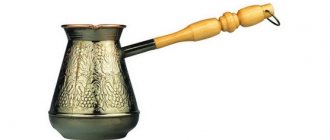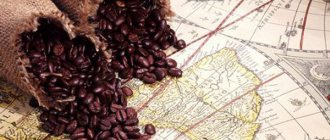No one knows for sure who was the first to see the red berries of the coffee tree and imagine that it could be turned into an invigorating drink, which is now valued in every corner of the world. The origins of coffee are shrouded in mystery and learning about it is absolutely fascinating. That's why, by reviewing articles, documents and legends, we decided to tell you all about the history of coffee and its origins. And in the next article you will get acquainted with the history of the spread of coffee across Europe, the North and South American continents.
antique coffee vessel from the Metropolitan Museum of Art in New York
Indeed, there are many more or less reliable and well-established stories about the origins of coffee. There are stories of a black and bitter drink that can give people energy, which Arab warriors use to gain courage in the toughest battles.
At the same time, others claim that the famous doctor, philosopher, mathematician and physicist Avicenna “invented” coffee: he allegedly gave it to his patients as a medicine already in the year 1000.
coffee plantation
Legends about the history of coffee
Another version of the story about coffee and its origins credits this discovery to a Yemeni shepherd named Kaldi, who, around 1400 (or in another version, around 500 AD), watched as his goats tasted these mysterious berries, suddenly became hyperactive.
Concerned about this behavior, he told the story to some religious ministers who, by studying and reflecting on it, realized the potential of the coffee plant.
How the Arab world discovered coffee
The birthplace of coffee is Ethiopia
So, the history of coffee dates back to 10th century Abyssinia, which is now Ethiopia, where coffee beans and their main attribute, caffeine, were first discovered. But it was not until the 13th century that coffee was first roasted, allowing it to become a cultural and economic product of Arab culture.
Arabic scientific documents dating back to around 900 AD refer to a drink native to Ethiopia known as bouna. This is one of the earliest references to Ethiopian coffee in its brewed form.
Most agree that the original coffee plants were native to the western regions of Ethiopia. Coffee was recorded as a drink as early as the 6th century, used by the Ottoman Empire. However, it was in Yemen that these plants were finally grown and developed into the grains and drinks we know today.
birthplace of coffee
Will I win or will I run?
Indeed, the first person singular form of the verb “to win” looks comical in both cases. And all because in the Russian language there is simply no such grammatical form. This may seem strange, given the diversity and richness of the Russian language, but if you look at the reasons for this absence, everything becomes clear.
There is a beautiful legend among the people that “to win” is not combined with the pronoun “I”, because one alone is not a warrior: for a Russian person it seems impossible to defeat the enemy alone. But what then to do with the words “convince”, “daring” and even “vacuum cleaning”? These verbs also do not have such a grammatical form.
In fact, the reason lies in the fact that alternation occurs in the first person singular in verbs of this type. So, “to win” should turn into “I will run” (and therefore the option “I will win” disappears by itself), “to dare” - into “I will hold”, and so on. It is easy to notice that in this form these words become similar to verbs of a completely different meaning (“run”, “hold”), and grammar cannot allow such coincidences. True, with regard to the word “vacuum cleaner” the language is not so categorical: it is quite possible that the form “vacuum cleaner” will eventually become the norm. So how can I say if I don’t “win” and don’t “run”? Simply replace the verb with the phrase “I will win.”
Yemeni coffee
Sufi mosques at the southern end of the Arabian Peninsula processed Yemeni coffee more than 500 years ago.
For 200 years, Yemen was the only source of coffee. This Arabic coffee was later named after the port of Mokha, which is located on the Red Sea coast, from where it was eventually exported.
Coffee plants there are still grown the old fashioned way, without the use of chemicals. Once the fruits, called "cherries", are ripe, they are picked by hand. The grains are processed dry. The fruit goes through a special period of drying in caverns, and in some cases on roofs. After the grains are dried, it is easy to separate them from the husks, then the latter are thrown away.
Yemeni coffee has a distinct taste and aroma. The complex earthy coloring of the beans often contains a hint of dried fruit, partly due to the drying method. Yemeni coffee also contains flavor notes of chocolate, cinnamon, cardamom or tobacco. The strongest of these notes is chocolate, which may explain the modern use of the word "mocha" in association with Yemeni coffee.
Coffee and knowledge of the coffee tree from Ethiopia and Yemen soon spread to Mecca and Cairo.
By the 16th century, coffee had reached the rest of the Middle East, South India (Karnataka), Persia, Turkey, the Horn of Africa (Northeast Africa) and North Africa.
Coffee then spread to the Balkans, Italy and the rest of Europe, as well as to Southeast Asia and America, despite prohibitions imposed in the 15th century by religious leaders in Mecca and Cairo, and later by the Catholic Church.
Yemeni coffee
Where did the word coffee come from?
The word "coffee" entered English in 1582 through the Dutch koffie, a loanword from the Ottoman Turkish qahwé, itself a loanword from the Arabic qahwah (قهوة).
The Arabic word qahwah originally referred to a type of wine, the etiology of which is given by Arab lexicographers as a derivative of the verb qahā (قها, "to lack hunger") due to the drink's reputation as an appetite suppressant.
The word qahwah sometimes alternatively comes from the Arabic quwwa ("strength, energy") or from Kaffa, a medieval kingdom in Ethiopia from which the plant was exported to Arabia. However, all etiologies of qahwah have been disputed.
The name qahwah is not used for the berry or plant, which is known in Arabic as bunn, and in Somali and Romo as būn. Semitic languages had the root qhh, "dark color", which became the natural designation for the drink. According to this analysis, the form qahwah (also meaning "dark-colored, dull, dry, sour") was probably chosen to parallel khamr (خمر, "wine"), and originally meant "dark".
Arab Bedouin with a cup of coffee, photo 1930
Who is this "sap"?
Errors that occur in phraseological units are also not uncommon. In some cases, stable phrases are broken intentionally, in others - out of ignorance of where the phraseological unit came from and what it means.
For example, you can often hear: “He did something on the sly.” But then what is “sap”? And why is he quiet?
In fact, there is no “sap”, but there is a phraseological unit “slyly”, and it came into our language from military usage. “Sapa” (the word is borrowed from the French language) is a hidden tunnel that allows you to unnoticedly approach the enemy or even undermine his fortifications. From this it becomes clear that doing something “on the sly” means unnoticed by others, secretly.
There are still a lot of inexplicable, at first glance, phenomena in the Russian language, amazing secrets and entertaining riddles that are worth the attention of not only philologists and linguists, but also native speakers themselves. Such knowledge will broaden your horizons and help you avoid mistakes in speech. Love your language!
Coffee and religion
Coffee was primarily consumed in the Islamic world, where it originated, and was directly associated with religious practice. For example, coffee helped consumers fast during the day and stay awake at night during the Muslim celebration of Ramadan.
Coffee also became associated with the birthday of the Prophet Muhammad. Indeed, various legends have attributed the origin of coffee to the prophet Muhammad, who, through the Archangel Gabriel, brought it to man to replace wine, which was forbidden by Islam.
vintage coffee jug
Sufis in Yemen used the drink as a means of concentration and a kind of spiritual enrichment when they repeated the name of the Almighty. Sufis used it to stay alert during night prayers.
Al-Jaziri's translation of the manuscript traces the spread of coffee from Arabia (modern-day Yemen) north to Mecca and Medina, and then to the larger cities of Cairo, Damascus, Baghdad and Constantinople.
By 1414 the plant was known in Mecca, and in the early 1500s it spread to the Mamluk Sultanate of Egypt and North Africa from the Yemeni port of Mocha.
In Cairo, many coffee shops associated with Sufism have sprung up around the religious Azhar University. These coffee houses also opened in Syria, especially in the cosmopolitan city of Aleppo, and then in Istanbul, the capital of the Ottoman Empire, in 1554.
In 1511 it was banned because of its stimulant effect by conservative orthodox imams at the theological court in Mecca. However, these prohibitions were lifted in 1524 by order of the Turkish Sultan Suleiman I, when the Grand Mufti Mehmet Ebussuud el-Imadi issued a fatwa allowing the consumption of coffee.
In Cairo, a similar ban was introduced in 1532, and coffee shops and warehouses with coffee beans were closed.
During the 16th century, it had already reached the rest of the Middle East, the Safavid Empire and the Ottoman Empire. From the Middle East, coffee consumption spread to Italy, then to the rest of Europe, and from Holland, coffee trees were transported to the East Indies and America.
Similarly, coffee was banned by the Ethiopian Orthodox Church some time before the 18th century. However, in the second half of the 19th century, Ethiopian attitudes toward coffee drinking softened, and its consumption spread rapidly between 1880 and 1886; According to British academic Richard Pankhurst, "this had a lot to do with Emperor Menelik dispelling the clergy's belief that 'this is the drink of the Muslims.'
Distribution and popularity
When considering the history of the drink, it is important to understand not only where it was discovered, but also how the product spread further. After the coffee drink was invented, it began to gain popularity in European countries.
How did coffee appear in Europe?
The drink came to Europe in the first half of the sixteenth century. The product gained popularity almost immediately. However, it was initially believed that this was an Islamic drink, and therefore Christians should not drink it. The clergy called the product “black blood of the Turks” and believed that it had a negative effect on the human soul.
The first to bring coffee to Europe were Venetian merchants. By that time, Europeans were already actively drinking tea and hot chocolate. In 1720, the first coffee shop, Café Florian, was opened. It exists in Venice to this day.
England
Coffee beans came to England in the seventeenth century. This happened through the British and Dutch East India Companies. The Oxford Queen's Lane Coffee House was opened in 1654. It still works today. In 1675, more than 3 thousand coffee houses were opened in England. During the period of enlightenment, active political and religious discussions took place in these institutions.
That is why Charles II even tried to close coffee shops. The king considered such establishments a haven for unemployed citizens who plotted against the government. In addition, many English ladies expressed dissatisfaction with the existence of coffee shops. They argued that men neglected family responsibilities by spending all their evenings in these establishments.
However, subsequently the English monarch had to cancel his decree. The fact is that coffee has already become an important part of the life of the British. Therefore, they began to express mass protests. This all led to the opening of coffee shops.
The history of instant coffee also did not bypass England. At the beginning of the twentieth century, English chemist George Washington, who lived in Guatemala, noticed sediment on his silver coffee maker. The scientist was not satisfied with this, and therefore he began to conduct experiments. Their goal was to completely dissolve the coffee. As a result, it was possible to launch mass production of the instant drink. The type of coffee Washington invented was called Red E Coffee.
America
Coffee came to America in 1700. This happened thanks to the French captain de Quellier, who grew a small plant during a long sea voyage across the Atlantic.
The coffee tree was then transplanted to the Caribbean island of Martinique. It became the forerunner of the 19 million trees that grew on the island over the next 50 years. De Quelliers noted that he had to make a lot of efforts to protect his plantations from the hands of enemies. They wanted to drive the navigator back to Europe.
In New York, coffee was originally made from roasted beans, adding sugar and honey to the drink. Coffee houses were considered real cultural centers and resembled English ones. However, subsequently the Americans introduced pieces of their culture into them. A special coffee fever began in the twenties of the last century. It is associated with the introduction of Prohibition in America.
Coffee in France
In 1669, Sultan Mehmed IV's ambassador Suleiman Agha brought a lot of coffee beans to Paris. He offered this drink to his French guests and also gave it to the royal court. Within a year, Parisians developed the custom of drinking coffee.
The first coffee shop in the world
The first coffee shop in the world appeared in 1475 in Constantinople. It was the Turks who made a serious contribution to the development of world coffee culture. To this day, Turkish coffee is considered one of the most common ways to brew a drink. At the beginning of the sixteenth century, coffee was introduced to Europe. In 1650, a merchant named Jacob opened a coffee shop in Oxford. By 1670, such establishments had been established in almost all major cities.
Holland
In 1616, trader Pieter van den Broecke brought coffee trees to Holland. The plants adapted perfectly to the conditions of the greenhouses of the Amsterdam Botanical Garden. It was from them that many Coffea arabica bushes grew. In 1658, the Dutch began to grow this crop in Ceylon, and subsequently in southern India. A few years later, the Dutch colonies became the main suppliers of coffee to European countries.
The first records where coffee is mentioned
The earliest mention of coffee, noted in writing by the coffee trader Philippe Sylvestre Dufour, is a reference to the work of a 10th century AD Persian physician. Muhammad ibn Zakariya al-Razi, known as the Razi of the West (Persian polymath, physician, alchemist, philosopher and important figure in the history of medicine). But more definite information about the preparation of a drink from roasted coffee berries dates back several centuries later.
One of the most important records on coffee was made by Abd al-Qadir al-Jaziri, who in 1587 wrote a work tracing the history and legal disputes about coffee entitled Umdat al-safwa fi hill al-Kahwa عمدة الصفوة في حل القهوة.” He reported that Sheikh Jamal al-Din al-Dhabhani (d. 1470), Mufti of Aden, was the first to adopt coffee (around 1454).
Coffee was also noted in Aleppo by the German botanist Leonhard Rauwolf, the first European to mention it in 1573.
Mocha coffee beans from Yemen
Coffee in Japan
Coffee was introduced to Japan by the Dutch in the 17th century, but remained a mere curiosity until trade restrictions were lifted in 1858. The first European-style coffee shop opened in Tokyo in 1888, and by the early 1930s there were more than 30,000 coffee shops throughout the country.
The introduction of freeze-dried instant coffee, canned coffee, and franchising in the late 20th century continued this trend, and Japan is now one of the leading per capita coffee consumers in the world.
Japanese coffee
How were women banned from drinking coffee?
Initially, coffee was considered a man's drink, so women were not allowed into coffee shops. This became a cause for outrage. Even Johann Sebastian Bach supported the women’s protest when he came up with the “Coffee Cantata.”
However, the ban on women visiting coffee shops was not universal. For example, it did not exist in Germany. Subsequently, representatives of the fairer sex began to be allowed into such establishments in other European countries.
Moreover, at that time, many were confident that coffee had healing properties. Famous doctors often recommended using the product for medicinal purposes. Some of them even recommended the drink to combat nervous disorders.
Vietnam is one of the main coffee exporters
Vietnam is one of the main coffee exporters in the world. Arabica has been the first imported coffee variety to Vietnam since 1857. Trung Nguyen coffee is the No. 1 coffee brand in Vietnam and is exported to more than 60 countries around the world. It was created in 1996 by Dang Le Nguyen Vu.
Large-scale production in Vietnam began after the normalization of trade relations with the United States in 1995. Almost all the coffee grown there today is Robusta.
Vietnamese women collecting coffee
Modern coffee industry
Today, coffee production is a huge global industry, employing more than 20 million people. In terms of trade volume, this commodity ranks second in the world after oil. Every year the world's population drinks more than 400 billion cups of coffee. It is considered the most popular drink in the world.
For example, in Brazil alone, more than 5 million people grow and harvest coffee. At the same time, there are more than 3 billion coffee plants in the country. In the United States, sales of the premium drink have reached multi-billion dollar figures. Moreover, they only increase every year.
One of the important inventions in this area is the creation of an espresso machine. It appeared in France in 1822. Subsequently, the Italians improved this product and were the first to manufacture it. Espresso has become an important part of Italian culture. Today there are more than 200 thousand espresso bars in Italy.
Coffee is a very interesting drink with a rich history. Appearing in Ethiopia, he became a real conqueror, conquering country after country. Today the coffee industry is considered one of the largest in the world.
Brazil is the largest coffee producer in the world
For many decades in the 19th and early 20th centuries, Brazil was the largest producer of coffee and a monopolist in the trade. However, the policy of keeping prices high soon opened up opportunities for other countries such as Venezuela, Colombia, Guatemala, Nicaragua, Indonesia and Vietnam, which are now second only to Brazil as the world's largest coffee producer.
bags of brazilian coffee
Coffee production in Ethiopia
Despite the origins of coffee cultivation in Ethiopia, the country produced only small quantities for export until the 20th century, and much of it not from the south of the country, but from the area around Harar in the northeast.
It is estimated that in the 1880s, the Kaffa province where the plants were located produced between 50,000 and 60,000 kg of coffee beans.
Commercial production actually began in 1907 with the establishment of the inland port of Gambela.
100,000 kg of coffee were exported from Gambela in 1908, while more than 4 million kg passed through the port in 1927–1928.
At the same time, coffee plantations were established in Arsi province, which were eventually exported via the Addis Ababa-Djibouti railway.
Although only 245,000 kilograms were transported by rail, this amount grew to 2,240,000 kilograms by 1922, surpassing Harari coffee exports by 1925, and reaching 9,260,000 kilograms in 1936.
coffee makers from the coffee museum in Italy
Drink or eat?
19th century - in Russia, coffee is enjoyed not only by members of the imperial family and those close to the Court, but also by ordinary citizens. The uniqueness of the process of consuming black coffee in Russia was that it was not drunk, but bitten. If you look into the works of such geniuses as Goncharov, Ostrovsky or Gogol, then their characters “ allowed themselves to have a bite of coffee . ” And, probably, at this very moment, the drink was given the status of a masculine gender, since “ coffee ” could not be classified as either feminine or neuter.
Linguists still don't understand why a word ending in " e " was defined as masculine rather than neuter. Some researchers suggest that during the time of Peter the Great, when there was a widespread Europeanization of not only everyday life, but also Russian speech, some words were pronounced in an overseas manner, but at the same time they used “ native ” word forms in parallel. That is, at that time, in the chambers of the nobility they could “ a bite ” of coffee (definitely masculine), and coffee, and kohei, and kefa, and coffee, and coffee, and the coffee we are accustomed to today.
In any case, today there are three theories why the word “coffee” is defined not by the middle, but by the male gender. According to the first, coffee as a word that came into Russian speech, either from German, or from Dutch, or from Italian, is precisely masculine in these languages. According to the second, it is a drink, and the word and concept “drink” itself is not neuter, but masculine. And finally, according to the third theory, the male gender of the word “coffee” was inherited from its predecessor “coffee”. By the way, it is Peter the Great who should be given credit for promoting and popularizing this aromatic drink. Today it seems strange to us that once upon a time someone opposed the spread of this invigorating and such an exquisite drink. But Peter the Great had to fight a fair bit with the boyars and Old Believers, who for some reason called coffee a demonic potion.
True, the magical properties of grains and grounds were confirmed by Italian witches, who used them to perform rituals to predict the future. Well, for modern people coffee is:
- a wonderful tonic drink;
- raw materials for medicines;
- component of cosmetics;
- decorative material for creating crafts;
- a way to have a great time with friends;
- one of the tools for performing magical rituals.
And, probably, of all the questions that interest the most pragmatic modern residents of megacities, this is the question, what is the “gender” of coffee? And also why is the word ending in “e”, contrary to all grammatical laws, not neuter, but masculine? Return to content
Australia harvests coffee mechanically
Australia is a small coffee producer with few products to export, but its coffee history dates back to 1880, when the first 500 acres of land began to be developed in the area between northern New South Wales and Cooktown, Queensland. Today there are several Arabica coffee producers in Australia that use a mechanical harvesting system invented in 1981.
modern coffee machines Post Views: 4,893











